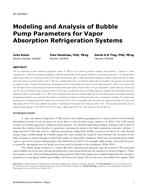Description
The core components of vapor absorption refrigeration systems (VARSs) are the absorber, generator, condenser and evaporator. A pump is a critical component of a VARS for circulating the refrigerant–absorbent solution from the low pressure absorber to the high pressure generator. A thermally-driven bubble pump, which can be powered by waste heat or solar thermal energy, offers a simple and efficient technique for lifting a liquid from lower to higher levels, after which it can fall by gravity. In the VAR cycle, a bubble pump can be used to lift the solution from the absorber to the generator and also desorb the refrigerant vapor. Extensive theoretical and experimental research has been performed in order to use the bubble pump for VARS. Some analyses have been developed based on air-lift pumps, some did not consider friction factor effects, two-phase flow, or the gas void fraction. Laminar flow was assumed and heat loss was not included in these analytical models. In this study, an analytical model of a bubble pump was developed and experimental work was conducted in order to use this pump in a VARS. In the simulation model, two-phase turbulent flow with heat loss, friction, surface tension effects and other thermophysical properties was considered. The model was validated by operating the bubble pump with water at atmospheric conditions. The bubble pump performance was investigated with tube diameters of 6 to 10 mm (0.24 to 0.4 in.) and lifting ratios (the ratio of the height of the liquid in the tube to the tube length) of 0.6 to 0.8, and at different heat inputs. Experimental results agreed with theoretical within 14%. The maximum liquid flow rate was obtained during slug flow at 160 watts (0.22 hp) heat input, a lifting ratio of 0.8, and a tube diameter of 10 mm (0.4 in.).
Citation: 2016 Annual Conference, St. Louis, MO, Conference Papers
Product Details
- Published:
- 2016
- Number of Pages:
- 8
- Units of Measure:
- Dual
- File Size:
- 1 file , 1 MB
- Product Code(s):
- D-ST-16-C001




